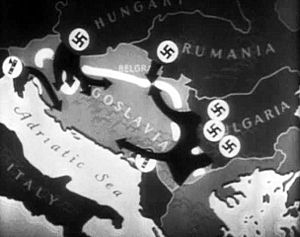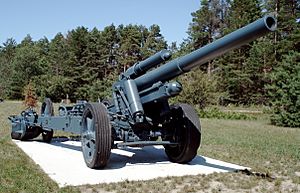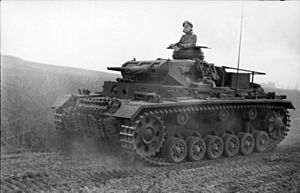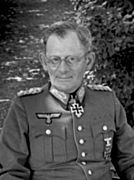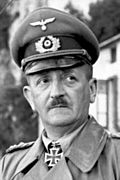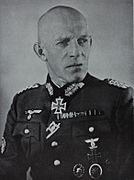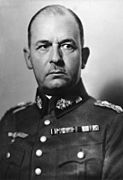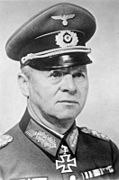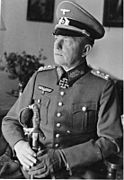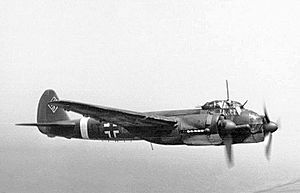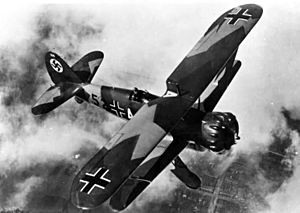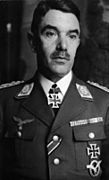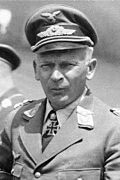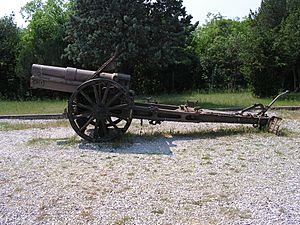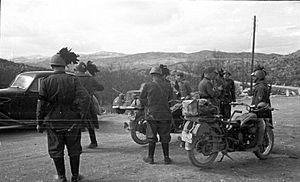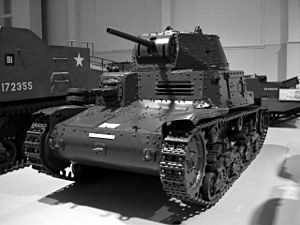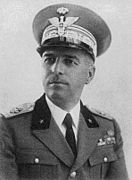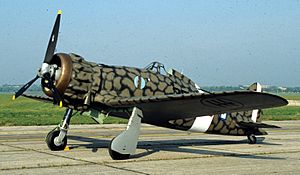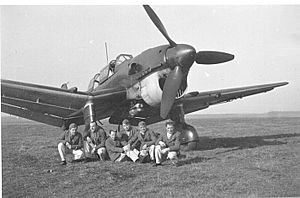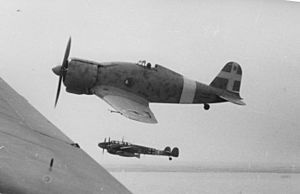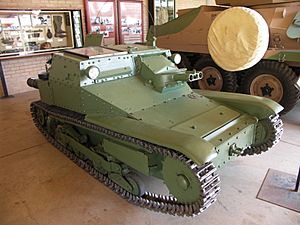Axis order of battle for the invasion of Yugoslavia facts for kids
This article explains the different armies, air forces, and navies that the Axis powers (Germany, Italy, and Hungary) used to invade Yugoslavia during World War II. The invasion began on April 6, 1941.
The main forces involved were the German 2nd Army and parts of the 12th Army, along with a large air force called the Luftwaffe. Germany had 18 divisions, including five panzer divisions (tank divisions), two motorised infantry divisions (soldiers who moved in vehicles), and two mountain divisions. They also had two special motorised regiments and over 800 aircraft.
Italy's 2nd Army and 9th Army sent 22 divisions, with the Royal Italian Air Force providing over 650 aircraft. Hungary's 3rd Army also joined, supported by the Royal Hungarian Air Force.
Before the invasion, the Axis ground forces had surrounded Yugoslavia. German troops were in Hungary and Austria, ready to attack from the north. Other German forces were in Bulgaria and Romania, prepared to strike from the east. The Italian 2nd Army was in northeastern Italy, planning to move down the coast. The Italian 9th Army was in Albania, mostly for defense. Hungarian forces were along the border, aiming to take certain regions.
Over 1,500 Axis aircraft were ready for the invasion, based in Austria, Italy, Hungary, Romania, Bulgaria, and Albania. Naval forces were limited to a few Italian destroyers in the Adriatic Sea.
German Forces
German Land Forces
Germany sent over 337,000 soldiers to invade Yugoslavia. They had more than 2,000 mortars, 1,500 artillery guns, 1,100 anti-tank guns, 875 tanks, and 740 other armored vehicles. The German land forces were led by Generalfeldmarschall Walther von Brauchitsch.
2nd Army
The German 2nd Army was commanded by Generaloberst Maximilian von Weichs. It was made up of one motorised corps, one mountain corps, and two infantry corps. These forces gathered in southwestern Hungary and southeastern Austria.
| Main Unit | Commander | Location | Divisions |
|---|---|---|---|
|
|
Heinrich von Vietinghoff |
|
8th Panzer Division (tanks) |
| 14th Panzer Division (tanks) | |||
| 16th Motorised Infantry Division (soldiers in vehicles) | |||
|
|
Ludwig Kübler |
|
1st Mountain Division (mountain troops) |
| 79th Infantry Division (foot soldiers) | |||
| 538th Frontier Guard Division (border guards) | |||
|
|
Hans-Wolfgang Reinhard |
|
101st Light Infantry Division (light infantry) |
| 132nd Infantry Division (foot soldiers) | |||
| 183rd Infantry Division (foot soldiers) |
12th Army
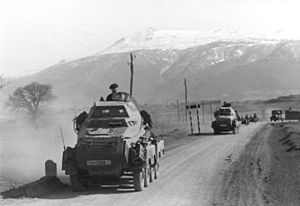
The German 12th Army was led by Generalfeldmarschall Wilhelm List. Most of this army was preparing to invade Greece. Only two motorised corps from the 12th Army were used in Yugoslavia. The First Panzer Group was also assigned to the 12th Army for the first part of the invasion.
| Main Unit | Commander | Location | Divisions or Regiments |
|---|---|---|---|
|
|
Georg Stumme |
southwest of Sofia, Bulgaria |
9th Panzer Division (tanks) |
| 73rd Infantry Division (foot soldiers) | |||
| Leibstandarte SS Adolf Hitler (elite motorized unit) | |||
|
|
Georg-Hans Reinhardt |
|
SS Motorised Infantry Division Reich (elite motorized unit) |
| Großdeutschland Motorised Infantry Regiment (elite motorized unit) |
First Panzer Group
The First Panzer Group was commanded by Generaloberst Paul Ludwig Ewald von Kleist. It gathered northwest of Sofia, Bulgaria.
| Main Unit | Commander | Divisions |
|---|---|---|
|
|
Gustav Anton von Wietersheim |
5th Panzer Division (tanks) |
| 11th Panzer Division (tanks) | ||
| 294th Infantry Division (foot soldiers) | ||
| 4th Mountain Division (mountain troops) | ||
| 60th Motorised Infantry Division (soldiers in vehicles) |
German Commanders
- Major German Army Commanders
German Air Force (Luftwaffe)
The Luftwaffe flew from bases in Austria, Romania, and Bulgaria. They had over 809 aircraft ready for the invasion. More than half of these were also supporting the invasion of Greece. The German air force included 296 fighter aircraft, 89 light bombers, 26 medium bombers, 23 reconnaissance aircraft, 318 dive bombers, and 57 heavy fighters.
4th Air Fleet
The Luftwaffe 4th Air Fleet was commanded by General der Flieger Alexander Löhr. Its headquarters was in Vienna, Austria. This fleet had 25 medium bombers, 89 light bombers, 55 dive bombers, 6 reconnaissance aircraft, and 1 heavy fighter.
Fliegerführer Graz
This air unit was commanded by Oberstleutnant Karl Christ and was based in Graz, Austria. It had 54 fighters, 1 medium bomber, and 35 dive bombers.
Fliegerführer Arad
This unit was commanded by Oberstleutnant Clemens Graf von Schönborn-Wiesentheid. Its headquarters was in Arad, Romania. It had 116 fighters, 31 heavy fighters, and 68 dive bombers.
VIII Air Corps
The VIII Air Corps was commanded by General der Flieger Wolfram Freiherr von Richthofen. He was in charge of all air operations for the invasion. This corps was based in western Bulgaria. It had 126 fighters, 17 reconnaissance aircraft, over 25 heavy fighters, and 160 dive bombers. These aircraft supported both the Yugoslavia and Greece invasions.
X Air Corps
The X Air Corps was based in Sicily, Italy. It had 168 aircraft, including bombers and fighters. It was available to help the 4th Air Fleet if needed, but its main job was to stop Allied supply ships going to Malta.
German Air Force Commanders
- Major German Luftwaffe Commanders
Italian Forces
Italian Ground Forces
The Italian 2nd Army and 9th Army sent 22 divisions, which was about 300,000 soldiers. This also included the Italian soldiers in Zara, an Italian area on the Dalmatian coast.
2nd Army
The Italian 2nd Army was commanded by Generale d’Armata Vittorio Ambrosio. It had one fast corps, one motorised corps, and three infantry corps. These forces gathered in northeastern Italy.
| Main Unit | Commander | Divisions |
|---|---|---|
|
|
Federico Ferrari Orsi |
1st Cavalry Division "Eugenio di Savoia" (horseback soldiers) |
| 2nd Cavalry Division "Emanuele Filiberto Testa di Ferro" (horseback soldiers) | ||
| 3rd Cavalry Division "Principe Amedeo Duca d'Aosta" (horseback soldiers) | ||
|
|
Riccardo Balocco |
15th Infantry Division "Bergamo" (foot soldiers) |
| 57th Infantry Division "Lombardia" (foot soldiers) | ||
| Guardia alla Frontiera (Border Guard) | ||
|
|
Lorenzo Dalmazzo |
12th Infantry Division "Sassari" (foot soldiers) |
| 20th Infantry Division "Friuli" (foot soldiers) | ||
| 26th Infantry Division "Assietta" (foot soldiers) | ||
|
|
Mario Robotti |
3rd Infantry Division "Ravenna" (foot soldiers) |
| 13th Infantry Division "Re" (foot soldiers) | ||
| 14th Infantry Division "Isonzo" (foot soldiers) | ||
| Guardia alla Frontiera (Border Guard) | ||
| 3rd Alpine Group (mountain troops) | ||
|
|
Francesco Zingales |
9th Infantry Division "Pasubio" (foot soldiers) |
| 52nd Infantry Division "Torino" (foot soldiers) | ||
| 133rd Armored Division "Littorio" (tanks) |
9th Army
The Italian 9th Army units involved were led by Generale d’Armata Alessandro Pirzio Biroli. They included two infantry corps and other troops stationed in northern Albania.
| Main Unit | Commander | Divisions |
|---|---|---|
|
|
Giovanni Vecchi |
38th Infantry Division "Puglie" (foot soldiers) |
| 4th Alpine Division "Cuneense" (mountain troops) | ||
|
|
Giuseppe Pafundi |
18th Infantry Division "Messina" (foot soldiers) |
| 32nd Infantry Division "Marche" (foot soldiers) | ||
| 131st Armored Division "Centauro" (tanks) | ||
|
|
Gabriele Nasci |
53rd Infantry Division "Arezzo" (foot soldiers) |
| 41st Infantry Division "Firenze" (foot soldiers) | ||
| 24th Infantry Division "Pinerolo" (foot soldiers) |
Zara Garrison
The Italian garrison (military base) in Zara had about 9,000 soldiers. It was commanded by Generale di Brigata Emilio Giglioli. This force included land defense units, sea defense units, and supporting artillery and engineer troops. They also had some small L3/35 tankettes.
Italian Commanders
- Major Italian Commanders
Royal Italian Air Force (Regia Aeronautica)
The Royal Italian Air Force flew from bases in Italy and Albania. They had 658 aircraft ready for the invasion. Some of these also supported the German invasion of Greece. The Italian air force had 296 fighter aircraft, 40 dive bombers, 192 medium bombers, 12 bomber floatplanes, and 118 reconnaissance aircraft.
2nd Air Force
The 2nd Air Force was based in Padua, Italy, and commanded by Generale di Squadra Aerea Tullio Toccolini. It had 90 fighters, 61 medium bombers, and 49 reconnaissance aircraft.
4th Air Force
The 4th Air Force was based in Bari, Italy, and commanded by Generale di Squadra Aerea Augusto Bonola. It had 73 fighters, 20 dive bombers, 131 medium bombers, and 12 bomber floatplanes.
Air Command Albania
Air Command Albania was located in Tirana, Albania, and commanded by Generale di Squadra Aerea Ferruccio Ranza. It had 133 fighters, 20 dive bombers, and 69 reconnaissance aircraft. These aircraft supported both the Yugoslavia and Greece invasions.
Three destroyers from the Royal Italian Navy were sent to the Adriatic Sea to directly support the invasion. Other ships were tasked with stopping the Royal Yugoslav Navy.
Hungarian Forces
Royal Hungarian Army
The Hungarian Army sent its Mobile Corps, I Corps, IV Corps, and V Corps from Vezérezredes Elemér Gorondy-Novák's 3rd Army to invade. The 1st Parachute Battalion was ready for airborne operations (dropping from planes). The Hungarian invasion force was positioned along the Yugoslav border, mainly between the Danube and Tisza rivers.
| Main Unit | Commander | Brigades or Battalions |
|---|---|---|
|
|
Béla Miklós |
1st Motorised Brigade (soldiers in vehicles) |
| 2nd Motorised Brigade (soldiers in vehicles) | ||
| 1st Cavalry Brigade (horseback soldiers) | ||
|
|
Zoltán Decleva |
1st Infantry Brigade (foot soldiers) |
| 13th Infantry Brigade (foot soldiers) | ||
| 15th Infantry Brigade (foot soldiers) | ||
|
|
László Horváth |
2nd Brigade (foot soldiers) |
| 10th Infantry Brigade (foot soldiers) | ||
| 12th Infantry Brigade (foot soldiers) | ||
|
|
Antal Silley |
14th Infantry Brigade (foot soldiers) |
| 19th Infantry Brigade (foot soldiers) | ||
| 2nd Cavalry Brigade (horseback soldiers) | ||
|
|
János Székely |
9th Infantry Brigade (foot soldiers) |
|
|
János Dömötör |
11th Infantry Brigade (foot soldiers) |
|
|
Árpád Bertalan |
1st Parachute Battalion (paratroopers) |
Royal Hungarian Air Force (MKHL)
The Royal Hungarian Air Force (MKHL) sent its 1st Air Brigade. This included four fighter groups with Fiat CR.42 biplane fighters. They also had one bomber group with Junkers Ju 86 and Caproni Ca.135bis bombers, and one reconnaissance group with Heinkel He 170A aircraft. Savoia-Marchetti SM.75 transport planes were used to carry the 1st Parachute Battalion.
See Also


